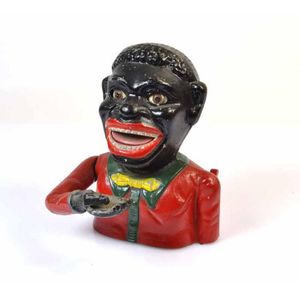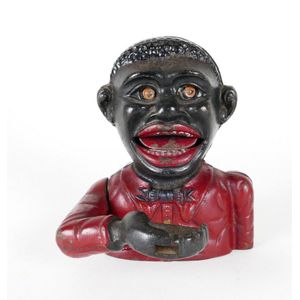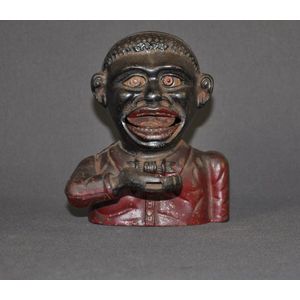Cartier Blackamoor Brooch with Enamel and Gems
18ct gold, gem-set and enamel 'Blackamoor' brooch, Cartier, Paris, circa 1938, the face applied with black enamel, the ears accented with articulated pearl earrings the head supporting a turban applied with cream enamel bet ween fluted dividers set to the front with a sarpech decorated with a rose diamonds surmounted by a Persian turquoise topknot, approximately 38 mm, signed Cartier, Paris, French maker's marks, numbered #05980, enamel deficient. Provenance;Marjorie Merriweather post, United States of America;private collection, acquired from the above;Literature;Judy Rudoe, Cartier 1900-1939, Harry N. Abrams, New York, 1 February 1997, p. 24 (illustrated, another example);Melissa Gabardi, Les Bijoux de l'Art Deco aux Annees 40, L'Amateur, Paris, 1986, p. 202 (illustrated, another example) . Vogue editor Diana Vreeland noted in her memoirs: 'My Little Blackamoor Heads Were the Chic of Paris in the Late 30s. When I Moved to New York, I Made Arrangements For Paris Cartier to Sell Them to the New York Cartier, and All I Can Tell You Is That the Race Across the Ocean Was Something Fierce.
You must be a subscriber, and be logged in to view price and dealer details.
Subscribe Now to view actual auction price for this item
When you subscribe, you have the option of setting the currency in which to display prices to $Au, $US, $NZ or Stg.
This item has been sold, and the description, image and price are for reference purposes only.
- Art Deco Period - The Art Deco period was a cultural movement that emerged in the 1920s and 1930s, and was characterized by its emphasis on modernism, luxury, and elegance. The name "Art Deco" comes from the Exposition Internationale des Arts Décoratifs et Industriels Modernes, a large exhibition held in Paris in 1925 that showcased the latest trends in decorative arts.
Art Deco was a reaction against the ornate and elaborate styles of the previous era, and reflected a new modern sensibility. It was characterized by streamlined, geometric shapes, bright colours, and the use of new materials such as chrome, glass, and Bakelite. Art Deco designers sought to create a sense of luxury and sophistication, often incorporating expensive materials such as ivory, marble, and rare woods.
Art Deco had a significant impact on a wide range of artistic fields, including architecture, fashion, graphic design, and interior design. Some of the most iconic examples of Art Deco architecture include the Empire State Building in New York City, the Hoover Building in London, and the Palais de Chaillot in Paris.
The Art Deco period came to an end in the 1940s, as World War II and changing cultural trends led to a shift in artistic styles. However, Art Deco remains an important influence on design and art, and continues to be celebrated for its modernist sensibility and glamorous aesthetic. - Circa - A Latin term meaning 'about', often used in the antique trade to give an approximate date for the piece, usually considered to be five years on either side of the circa year. Thus, circa 1900 means the piece was made about 1900, probably between 1895 and 1905. The expression is sometimes abbreviated to c.1900.
This item has been included into following indexes:
- Art Deco jewellery - brooches, period or age 284
- brooches, diamond
- brooches, gold
- brooches, set with - gem-set 6
- Cartier (France), jewellery
Visually similar items

An Americana 'Jolly Nigger' money box, mechanical action, cast aluminium. Height 16 cm
Sold by
in
for
You can display prices in $Au, $US, $NZ or Stg.

A large dark pounamu hei tiki, modelled with hands to side, head tilted with chin to left shoulder, ring eyes. Height 14 cm
Sold by
in
for
You can display prices in $Au, $US, $NZ or Stg.

An old Little Joe cast iron mechanical bank, made by John Harper Co., England, c.1910. Original baseplate in tact
Sold by
in
for
You can display prices in $Au, $US, $NZ or Stg.

Little Joe cast iron bank. Later version of Jolly N. R bank. Height 14 cm
Sold by
in
for
You can display prices in $Au, $US, $NZ or Stg.
